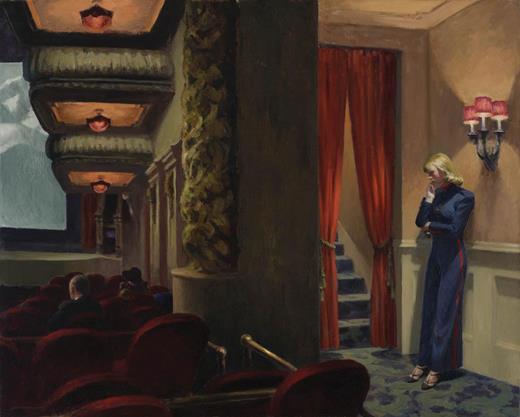-
PDF
- Split View
-
Views
-
Cite
Cite
Mike McKiernan, Edward Hopper, New York Movie 1939, Occupational Medicine, Volume 67, Issue 3, 1 April 2017, Pages 174–175, https://doi.org/10.1093/occmed/kqx024
Close - Share Icon Share
A solid end-wall with an ornate leafy column separates the star of the show (an usherette) from the show of the stars (the movie). Two horizontal brass hand-rails complete the critical division between the subdued but luxuriant glow of fantasy land and the harsh glare of the real world. On the left, three glass lanterns suspended in echelon from the lofty ceiling cast a soft light over plush red velvet seats, where a solitary man and woman ambiguously occupy separate rows in a dark, empty, cavernous auditorium. They stare featureless at the large black and white cinema screen. She wears a floppy wide-brimmed hat and a fur-collared coat, while he is bare-headed but neatly trimmed and suited, his white shirt collar conspicuous in the gloom. On the right the unforgiving lumens from a triple candlestick wall-light (complete with pink shades) capture the pensive form of a tall, beautifully coiffured young woman, stylishly tailored in a military-styled uniform. The smart royal-blue suit has brass buttons, epaulettes, red stripes down wide bottom trousers and complementary red flashes on the cuffs and collar. A pair of black, strappy, high-heel sandals completes the ensemble. Her face is clouded, her eyes closed; she seems deep in thought, her chin resting on her right hand, supported by her left, which clutches a torch (flashlight). She rests her back resignedly against the dado rail of the half-panelled wall behind her. In front, tied-back burnt-orange curtains reveal grey-blue carpeted stairs, which lead up and out of the cinema into the threatening world beyond. The grisaille vignette on the cinema screen displays snowy Himalayan peaks from Frank Capra’s 1937 blockbuster movie Lost Horizon [1], a story about Shangri-la—a lost sanctuary of peace and safety [2]. Yet the usherette chooses not to watch the film. It provides her with no escape from the theatrum mundi.
Hopper, Edward (1882-1967): New York Movie, 1939. New York, Museum of Modern Art (MoMA). Oil on canvas, 32 1/4 x 40 1/8’ (81.9 x 101.9 cm). Given anonymously. Acc. n.: 396.1941. © 2017. The Museum of Modern Art, New York/Scala, Florence
The artist is Edward Hopper, the usherette his artist wife Jo, who modelled for many of his paintings. They loved the movies and visited them often from their modest step-up apartment in Greenwich Village, New York where they lived for 40 years [2]. Hopper made >50 preparatory sketches at the Palace Theater, Times Square before completing the painting at his apartment studio. With its cropped Degas composition, dramatic lighting and lonely people New York Movie typifies Hopper’s style, though he stated that his pictures contained no social meaning [2] and that ‘the loneliness thing is overdone’ [3].
Edward Hopper was born into a middle-class Baptist family in Nyack, NY (1882). After graduating from high school, he studied for a year at the Correspondence School of Illustrating in New York City followed by 6 years at the New York School of Art [4]. Between 1906 and 1910, he made three trips to Paris where he was greatly influenced by the works of Degas and Manet, embracing their use of colour, light and form. On his return to New York, Hopper continued to work as a commercial artist and illustrator [3] but gave up after he married Jo Nivison a fellow artist (1924). Jo would become his fiercest supporter, carefully documenting his work, sales and exhibitions as well as recording details of their travels, struggles and tempestuous life together [5]. She was with him when he died in his armchair at his studio (1967) and donated his entire estate (>3000 pieces) to the Whitney Museum of American Art [6]. She died 9 months later.
Hopper was a puritanical, disciplined, introverted man, a life-long conservative who liked privacy [7]. Tall and taciturn, he was an imposing figure (2 m tall), a man of few words, whose still, tense, laconic paintings ‘filled with emptiness and silence’ [8] closely matched his temperament. His brand of American realism fell out of favour with the rise of abstract expressionism in the 1940s and 50s but in recent times his ‘poignantly captured tension and irony of modern American life’ [9] has recast him as ‘one of the major Realist painters of the 20th century’ [3].
However, the make-belief world of the movie set is not above the law. The UK Health and Safety Executive recently charged the producers of Star Wars: The Force Awakens with breaches of health and safety laws following an incident when a famous film star broke his leg [10]. Movie makers may also have broader responsibilities for public health issues such as the smoking and dietary habits of ‘innocent’ moviegoers [11,12]. The US Office on Smoking and Health at the Centers for Disease Control and Prevention has decided it will now track and report annually on tobacco use imagery in youth-oriented movies [13] but with what results? ‘Here’s looking at you, kid’ [14].
References
Author notes
e-mail: art@som.org.uk




